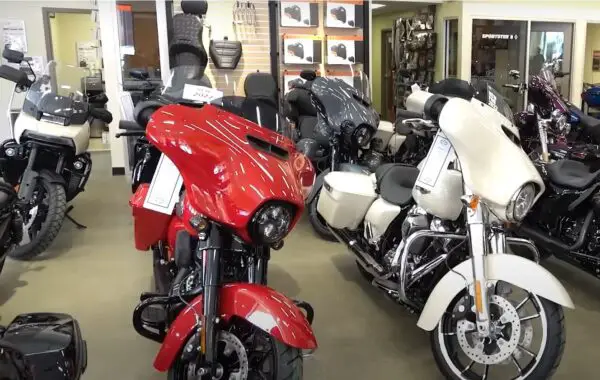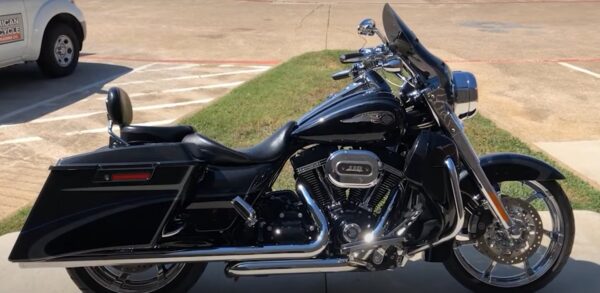The Harley Fat Boy is an iconic motorcycle known for its design and powerful performance.
However, like any long-standing model, there have been years where the Fat Boy faced challenges in terms of reliability, performance, or design tweaks that didn’t resonate with the core audience.
For potential buyers or enthusiasts, it’s essential to be aware of these specific years to make an informed decision. This guide will explore those particular years for the Harley Fat Boy that might be avoided.
Let’s dive in!
Which Harley Fatboy Years You Should Avoid?

These are the worst years of Harley Fatboy, which you should consider avoiding.
Related: Years to Avoid Harley Electra Glide
1. Harley Fatboy Model 2007

Most of the riders reported similar problems with their 2007 model Fatboy.
Rear Tire Wear faster
One of the notable problems that is mostly reported by the riders with the 2007 Harley Fatboy is the rapid wear of the rear Tire. Several factors contribute to this issue.
Firstly, the weight distribution of the Fatboy, combined with its powerful torque, can put additional stress on the rear Tire.
It is especially true when riders frequently accelerate hard or carry a passenger and luggage, which further increases the load on the rear wheel.
Another factor is the type of Tire used. Some stock tires provided on the 2007 Fatboy might not have been optimized for longevity, especially when subjected to the unique stresses of a heavyweight cruiser like the Fatboy.
It’s also worth noting that tire pressure plays a significant role in tire longevity. If riders do not maintain the recommended tire pressure, it can lead to uneven and accelerated wear.
Short Rear Fender Issue
Another design aspect some riders have pointed out as problematic on the 2007 Fatboy is the short rear fender.
While the shorter fender gives the bike a distinctive and sleek look, it has practical implications. The primary concern is that it doesn’t offer as much protection from road debris, water, and mud as a longer fender would.
Riders often find their backs splashed during wet conditions, and the bike can get dirtier faster and require more frequent cleaning. Moreover, the shorter fender can throw more debris onto the rear suspension components and the under-seat electronics.
Over time, it can lead to faster wear and tear or potential damage to these components.
Related: Which Shovelhead Years You Should Avoid?
2. Harley Fatboy Model 2006

The Harley-Davidson Fatboy is a popular model from the iconic motorcycle manufacturer. Over the years, various models have experienced certain issues, and the 2006 Fatboy was no exception.
Here’s a detailed look at some of the problems that have been reported:
Brake Lights Failure
One of the common issues with the 2006 Fatboy was the failure of brake lights. Brake lights are crucial for safety, as they signal to the vehicles behind that the motorcycle is slowing down or stopping.
Some owners reported that the brake lights intermittently fail or do not work. This problem could be due to various causes, including faulty wiring, blown fuses, or a malfunctioning brake light switch.
Alarm System Issues
Another problem faced by some 2006 Fatboy owners was related to the alarm system. Specifically, the alarm would not disarm, even when the correct procedures were followed.
It could lead to situations where riders could not start their bikes or faced unexpected alarm triggers.
Potential causes for this issue could be a faulty alarm module, drained batteries in the key fob, or issues with the bike’s electrical system.
Ignition Problems
The ignition system is the heart of any motorcycle, and some 2006 Fatboy owners reported related issues.
Problems ranged from the bike not starting at all to intermittent ignition failures. These issues could be due to a faulty ignition switch, problems with the ignition coil, or even issues with the bike’s battery.
Regular maintenance and checks can help in identifying and rectifying these problems early on.
3. Harley Fatboy Model 2003

Most owners reported the carburetor and not starting related problems of the 2003 Fatboy.
Carburetor Problem
The 2003 Harley-Davidson Fatboy, like many motorcycles of its era, uses a carburetor system for fuel delivery.
Over time, carburetors can develop issues that can prevent the bike from starting. Here are some common problems related to the carburetor:
Dirty or Clogged Carburetor
Over time, old fuel can leave deposits in the carburetor, leading to clogs. It can prevent the proper mixture of air and fuel, making it difficult or impossible to start the bike.
Improper Jetting
The carburetor jets control the amount of fuel that mixes with air. If they’re not set correctly, it can lead to a lean or rich mixture, which can cause starting issues.
This is especially concerning if modifications have been made to the exhaust or air intake without adjusting the carburetor.
Faulty Floats
The float in the carburetor controls the amount of fuel that enters the system. If it’s malfunctioning, it can either flood the engine with too much fuel or starve it, preventing it from starting.
Vacuum Leaks
The carburetor relies on a proper vacuum to draw fuel into the engine. Any leaks can disrupt this balance and prevent the bike from starting.
Choke Issues
The choke helps in starting the bike, especially in colder conditions, by enriching the fuel mixture. If it does not function properly, then it can cause starting problems.
Related: Which are the Best Years to Buy a Harley Sportster?
4. Harley Fatboy Model 1999

Hot Starting Issue
Hot starting problems refer to a motorcycle’s difficulty when trying to start after it has been running and is still warm.
It contrasts with cold starting issues, which occur when the bike has been off for a prolonged period, especially in colder temperatures.
Hot starting problems can be particularly frustrating because they often occur after short stops, like refueling or after a brief rest.
Spitting and Popping
It is a clear indication of a mixture problem or ignition issue. Spitting happens when there’s a lean air/fuel mixture, or the ignition timing is off.
Popping, on the other hand, can be due to unburned fuel entering the exhaust and igniting.
Bogging After 2 Miles
If the motorcycle starts fine but then bogs down after a short distance, it could be due to various reasons.
It might be a fuel delivery problem, a clogged vent in the gas cap, or even an ignition component that fails when it gets hot.
FAQ
Why is the Harley Fat Boy so popular?
The Harley Fat Boy is popular due to its iconic design, powerful performance, and association with American motorcycle culture.
Its robust appearance and association with movies like “Terminator 2” have solidified its legendary status among enthusiasts.
What is the top speed of the Fat Boy?
The top speed of the Harley-Davidson Fat Boy varies by model year and engine size, but many versions can reach speeds of around 105-110 mph.
However, actual performance can be influenced by factors like modifications, rider weight, and road conditions.
Wrapping Up
When you’re considering purchasing a Harley-Davidson Fat Boy, it’s essential to research specific model years to ensure a satisfactory riding experience.
While the Fat Boy is an iconic and generally well-regarded motorcycle, like all vehicles, certain years may have had issues or recalls.
If you’re a potential buyer, you should consult reviews, forums, and recall databases to identify problematic years.
Doing so lets you make an informed decision, ensuring you’re invested in a bike that offers the legendary Harley experience and dependable performance.
You may love to read!

Ahtsham Younas is a passionate blogger and content writer. He loves to ride motorcycles and learn the mechanical process behind the motorcycles.
He has been writing articles in the motorcycle industry since 2019 and has learned many things about motorbike niches.


